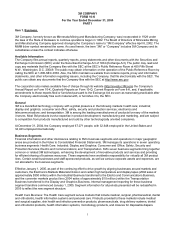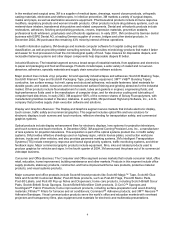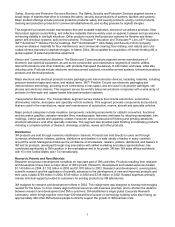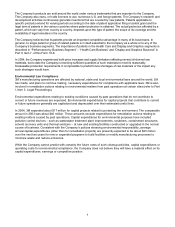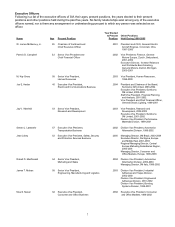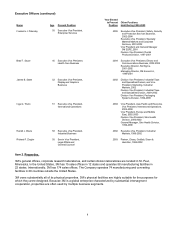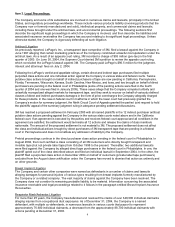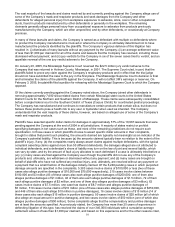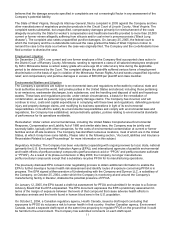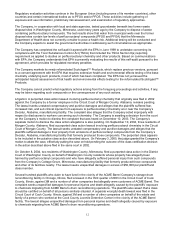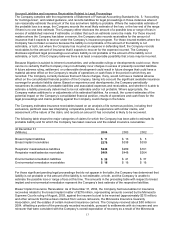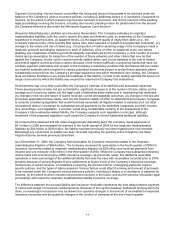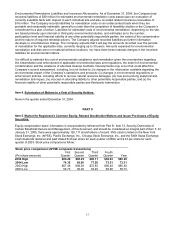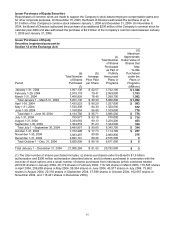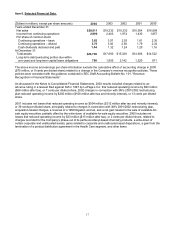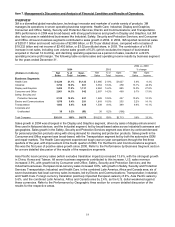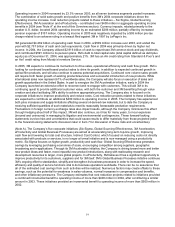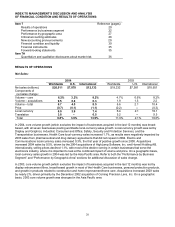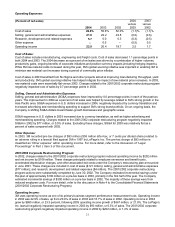3M 2004 Annual Report Download - page 37
Download and view the complete annual report
Please find page 37 of the 2004 3M annual report below. You can navigate through the pages in the report by either clicking on the pages listed below, or by using the keyword search tool below to find specific information within the annual report.
11
believes that the damage amounts specified in complaints are not a meaningful factor in any assessment of the
Company’s potential liability.
The State of West Virginia, through its Attorney General, filed a complaint in 2003 against the Company and two
other manufacturers of respiratory protection products in the Circuit Court of Lincoln County, West Virginia. The
complaint seeks substantial, but unspecified, compensatory damages primarily for reimbursement of the costs
allegedly incurred by the State for worker’s compensation and healthcare benefits provided to more than 20,000
current or former miners allegedly suffering from silicosis and/or coal miner’s pneumoconiosis (“Black Lung
disease”). The complaint also seeks unquantified punitive damages. On January 25, 2005, the federal court to
which the Company and the co-defendants removed the case granted the State of West Virginia’s motion to
remand the case to the state court where the case was originally filed. The Company and the co-defendants have
filed a motion to dismiss the case.
Employment Litigation
On December 21, 2004, one current and one former employee of the Company filed a purported class action in
the District Court of Ramsey County, Minnesota, seeking to represent a class of all salaried employees employed
by 3M in Minnesota below a certain salary grade who were age 46 or older at any time during the applicable
period to be determined by the Court. The complaint alleges the plaintiffs suffered various forms of employment
discrimination on the basis of age in violation of the Minnesota Human Rights Act and seeks unspecified injunctive
relief, and compensatory and punitive damages in excess of $50,000 per plaintiff and class member.
Environmental Matters and Litigation
The Company’s operations are subject to environmental laws and regulations enforceable by national, state and
local authorities around the world, and private parties in the United States and abroad, including those pertaining
to air emissions, wastewater discharges, toxic substances, and the handling and disposal of solid and hazardous
wastes. These laws and regulations provide, under certain circumstances, a basis for the remediation of
contamination, as well as personal injury and property damage claims. The Company has incurred, and will
continue to incur, costs and capital expenditures in complying with these laws and regulations, defending personal
injury and property damage claims, and modifying its business operations in light of its environmental
responsibilities. In its effort to satisfy its environmental responsibilities and comply with environmental laws and
regulations, the Company has established, and periodically updates, policies relating to environmental standards
of performance for its operations worldwide.
Remediation: Under certain environmental laws, including the United States Comprehensive Environmental
Response, Compensation and Liability Act of 1980 and similar state laws, the Company may be jointly and
severally liable, typically with other companies, for the costs of environmental contamination at current or former
facilities and at off-site locations. The Company has identified numerous locations, most of which are in the United
States, at which it may have some liability. Please refer to the following section, “Accrued Liabilities and Insurance
Receivables Related to Legal Proceedings” for more information on this subject.
Regulatory Activities: The Company has been voluntarily cooperating with ongoing reviews by local, state, national
(primarily the U.S. Environmental Protection Agency (EPA)), and international agencies of possible environmental
and health effects of perfluorooctanyl compounds (perflurooctanoic acid or “PFOA” and perfluorooctane sulfonate
or “PFOS”). As a result of its phase-out decision in May 2000, the Company no longer manufactures
perfluorooctanyl compounds except that a subsidiary recycles PFOA for its manufacturing operations.
The previously disclosed EPA consent order negotiating process to obtain additional information to enable the
EPA to further develop a human health risk assessment and identify routes of exposure concerning PFOA is in
progress. The EPA signed a Memorandum of Understanding with the Company and Dyneon LLC, a subsidiary of
the Company, on October 25, 2004, under which the Company is monitoring at and around the Company’s
manufacturing facility in Decatur, Alabama the potential presence of PFOA.
On January 12, 2005, the EPA issued a draft risk assessment for PFOA and submitted it for review to a Science
Advisory Board that the EPA empanelled. The EPA document expresses the EPA’s preliminary assessment in
terms of the margin of exposure between the levels of that compound that cause adverse health effects in
laboratory animals and the levels found in human blood sera in the U.S. population.
On October 2, 2004, a Canadian regulatory agency, Health Canada, issued a draft report concluding that
exposures to PFOS do not pose a risk to human health in that country. Another Canadian agency, Environment
Canada, issued a separate draft report at the same time proposing to regulate PFOS on the ground that it could
be harmful to the environment. The Company has submitted comments on each draft report.




